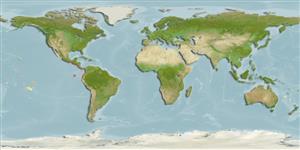Environment: milieu / climate zone / depth range / distribution range
Écologie
marin récifal; profondeur 0 - 25 m (Ref. 57763). Tropical; 27°N -
Eastern Pacific: Gulf of California to Peru, including the Galapagos Islands.
Taille / Poids / Âge
Maturity: Lm ? range ? - ? cm
Max length : 120 cm TL mâle / non sexé; (Ref. 57763); common length : 60.0 cm TL mâle / non sexé; (Ref. 57763)
Lives in rocky, boulder strewn areas and walls. Lurks in holes, crevices and dark recesses. Constantly opens and closes its mouth, an action required for respiration, not a threat (Ref. 5227).
Life cycle and mating behavior
Maturities | Reproduction | Spawnings | Egg(s) | Fecundities | Larves
McCosker, J.E. and R.H. Rosenblatt, 1995. Muraenidae. Morenas. p. 1303-1315. In W. Fischer, F. Krupp, W. Schneider, C. Sommer, K.E. Carpenter and V. Niem (eds.) Guia FAO para Identification de Especies para lo Fines de la Pesca. Pacifico Centro-Oriental. 3 Vols. FAO, Rome. (Ref. 9324)
Statut dans la liste rouge de l'IUCN (Ref. 130435)
Menace pour l'homme
Harmless
Utilisations par l'homme
Outils
Articles particuliers
Télécharger en XML
Sources Internet
Estimates based on models
Preferred temperature (Ref.
123201): 23.1 - 29.1, mean 27.3 °C (based on 229 cells).
Phylogenetic diversity index (Ref.
82804): PD
50 = 0.5010 [Uniqueness, from 0.5 = low to 2.0 = high].
Bayesian length-weight: a=0.00050 (0.00025 - 0.00101), b=3.26 (3.10 - 3.42), in cm total length, based on LWR estimates for this (Sub)family-body shape (Ref.
93245).
Niveau trophique (Ref.
69278): 4.0 ±0.6 se; based on size and trophs of closest relatives
Résilience (Ref.
120179): Très faible, temps minimum de doublement de population supérieur à 14 ans (Preliminary K or Fecundity.).
Fishing Vulnerability (Ref.
59153): High to very high vulnerability (72 of 100).
Nutrients (Ref.
124155): Calcium = 25.6 [13.5, 43.4] mg/100g; Iron = 0.41 [0.24, 0.91] mg/100g; Protein = 18.8 [16.6, 21.4] %; Omega3 = 0.0915 [, ] g/100g; Selenium = 41.9 [22.3, 84.5] μg/100g; VitaminA = 54.2 [15.3, 176.3] μg/100g; Zinc = 0.891 [0.627, 1.247] mg/100g (wet weight);
